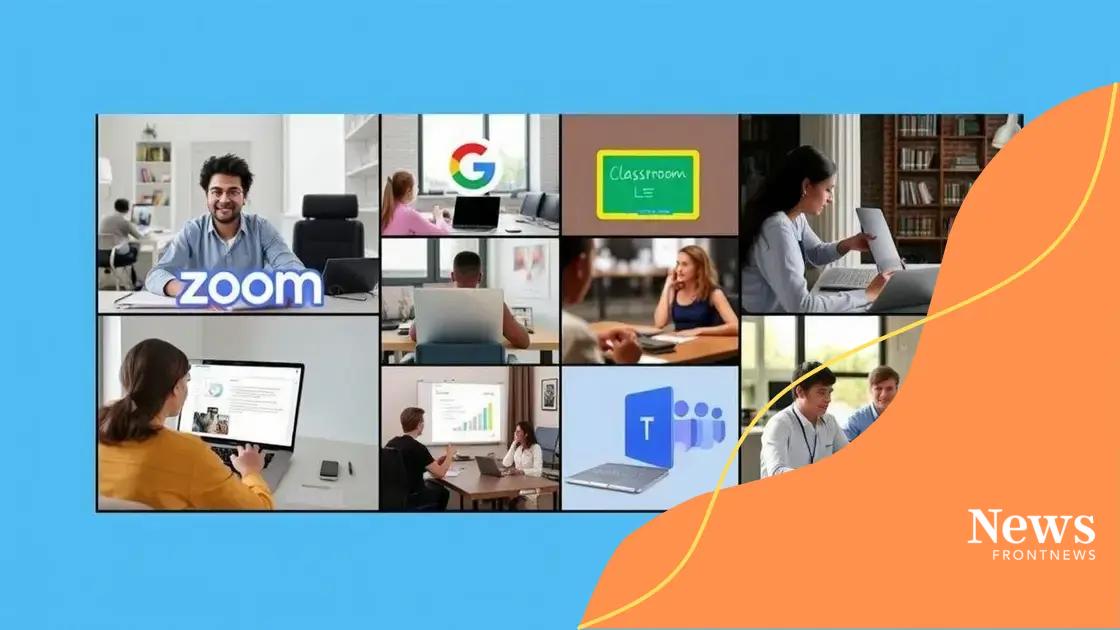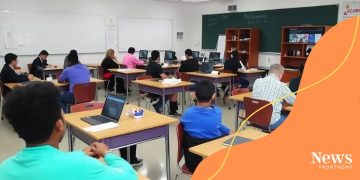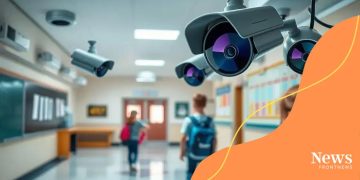Remote learning platforms: redefining education access

Remote learning platforms offer flexibility, accessibility, and personalized learning experiences through AI integration, while fostering student engagement and collaboration in hybrid educational models.
Remote learning platforms have emerged as a game changer in education, making learning accessible to students across the globe. Have you considered how these platforms might fit into your study routine?
Understanding remote learning platforms
Understanding remote learning platforms is essential in today’s education landscape. These platforms offer innovative solutions for students, parents, and educators. Knowing how they function can empower users to make the most of online learning.
What are remote learning platforms?
Remote learning platforms are digital tools that facilitate learning outside traditional classrooms. They allow students to access educational materials and interact with teachers and peers from anywhere. This flexibility is particularly beneficial in our increasingly mobile world.
Key features of remote learning platforms
- Real-time video conferencing for live classes.
- Access to recorded lectures and resources.
- Interactive tools for assignments and quizzes.
- Discussion forums for peer-to-peer interaction.
These features create an engaging learning environment. With remote learning platforms, students can learn at their own pace, revisit materials, and collaborate with classmates in unique ways. The ability to attend lectures remotely allows for better time management.
Additionally, these platforms often integrate various multimedia resources, making the learning experience more immersive. Videos, articles, and interactive simulations cater to different learning styles, ensuring that every student finds something that resonates with them.
Benefits of using remote learning platforms
Embracing remote learning platforms offers numerous advantages. Students gain flexibility and can customize their study schedules. This is crucial for those balancing education with work or other commitments.
- Enhances accessibility for students in remote areas.
- Provides a wide range of courses and subject matter experts.
- Encourages self-directed learning.
For parents, these platforms can provide insights into their child’s progress. Many offer tracking features that allow parents to monitor performance and engagement. Overall, remote learning platforms bring education into the 21st century, promoting inclusivity and adaptability.
Key benefits of using remote learning platforms
Understanding the key benefits of using remote learning platforms can greatly enhance the educational experience for students and educators alike. These platforms offer distinct advantages that can change how we view education.
Flexibility and Accessibility
One of the most notable benefits is flexibility. Students can learn at their own pace and choose schedules that fit their lifestyles. This is especially helpful for those who balance school with work or family responsibilities. Additionally, these platforms are accessible from anywhere with an internet connection, allowing students in remote or underserved areas to access quality education.
Diverse Learning Resources
Another important advantage is the variety of resources available. Remote learning platforms often provide a wealth of multimedia content, such as videos, articles, and interactive quizzes. This variety supports different learning styles, ensuring that all students can find materials that resonate with them.
- Access to expert-led courses and tutorials
- Interactive simulations for practical learning
- Collaboration tools for group projects
- Instant feedback on quizzes and assignments
This diversity not only keeps students engaged but also empowers them to explore topics that interest them deeply. Moreover, blending various resources can lead to a richer understanding of complex subjects.
Enhanced Collaboration Opportunities
Using remote learning platforms also encourages collaboration among students. They can communicate and share ideas through discussion forums and group projects. This interaction promotes teamwork and helps build crucial soft skills that are important for future careers.
Additionally, many platforms provide tools for teachers to track student progress. This means timely interventions can be made if a student struggles with a concept. Such proactive support can inspire student confidence and improve overall outcomes.
By adopting these platforms, educational institutions can enhance their teaching methods, making learning more dynamic and engaging for everyone involved. With these benefits, it is clear why many are opting for remote learning platforms in today’s world.
Popular remote learning platforms in the market

There are several popular remote learning platforms that cater to different educational needs. Each platform offers unique features that can enhance the online learning experience for students and teachers alike.
Key Platforms and Their Features
Some of the most widely used platforms include Zoom, Google Classroom, and Microsoft Teams. These tools provide essential functionalities that support virtual learning.
- Zoom: Known for its video conferencing capabilities, Zoom allows for live classes, breakout rooms for group work, and recording options.
- Google Classroom: This user-friendly platform integrates with Google Drive and Docs, making it easy to share assignments and feedback.
- Microsoft Teams: This platform combines video calls with document collaboration, making it ideal for team projects and communication.
In addition to these, platforms like Moodle and Edmodo serve specific educational purposes. Moodle is a popular choice among higher education institutions, offering robust course management features. It allows educators to create tailored courses and track student progress. Edmodo, on the other hand, focuses on K-12 education, providing a safe social learning environment.
Specialized Learning Tools
Beyond general remote learning platforms, there are specialized tools designed to enhance certain aspects of learning. Platforms like Khan Academy and Coursera offer structured courses and resources that cater to specific subjects.
- Khan Academy: Provides free instructional videos and exercises in various subjects, making learning accessible for all.
- Coursera: Collaborates with universities to offer courses that can lead to certifications, giving students recognized credentials.
These platforms are changing how education is delivered. By evaluating the strengths of each, educators and students can select the best options to meet their learning goals. As the demand for online education grows, these popular remote learning platforms will continue to play a vital role in shaping the future of learning.
Best practices for engaging with remote learning
Engaging effectively with remote learning requires a few best practices that can enhance the experience for both students and educators. These strategies can create a more interactive and fruitful learning environment.
Establish Consistent Communication
Effective communication is essential in a remote learning setting. Setting regular check-ins can help address any concerns or questions. Utilizing various platforms like emails, discussion boards, and chats fosters an open line of communication.
Encourage Active Participation
Encouraging students to participate actively in discussions and activities is vital. Strategies such as asking open-ended questions and using interactive polls can keep learners engaged. Additionally, incorporating breakout rooms in video calls allows students to collaborate in smaller groups, enhancing their involvement.
- Use icebreaker activities to build rapport.
- Assign group projects to foster teamwork.
- Incorporate quizzes and polls for instant feedback.
- Encourage students to share their thoughts and resources.
When students know their voices matter, they are more likely to engage and contribute meaningfully to discussions. Providing opportunities for peer feedback also enhances their learning experience.
Provide Clear Guidelines and Expectations
Being clear about expectations helps students understand what is required. Every learning objective should be specific and achievable. Providing rubrics for assignments can guide students on how their work will be evaluated.
Moreover, setting a structured schedule for classes and deadlines can help students manage their time effectively. Ensuring that materials and resources are easily accessible allows for smooth navigation of the learning process.
Maintaining a sense of structure within the flexible environment of remote learning is key to encouraging student accountability and success.
Future trends in remote learning platforms
Exploring the future trends in remote learning platforms reveals exciting innovations on the horizon. As technology evolves, these platforms will likely incorporate new features designed to enhance the learning experience.
Increased Integration of Artificial Intelligence
One significant trend is the incorporation of artificial intelligence (AI) to personalize learning. AI can analyze a student’s performance and adapt content to meet their needs. This customization helps provide tailored resources and support, making learning more effective.
Growth of Hybrid Learning Models
Another important trend is the rise of hybrid learning models, which combine traditional in-person education with remote learning. This approach allows for more flexibility and can cater to different learning styles. Students can benefit from face-to-face interaction while still enjoying the advantages of online resources.
- Flexibility in learning environments.
- Greater accessibility for students.
- Enhanced collaboration opportunities.
- Improved use of technology in education.
As schools and universities begin to adopt these hybrid models, the need for robust and adaptable remote learning platforms will continue to grow. This evolution aims to create a more comprehensive educational experience.
Focus on Social Emotional Learning
Future remote learning platforms are also expected to focus on social-emotional learning (SEL). This trend emphasizes the importance of emotional intelligence alongside academic achievement. Providing resources for mental health and well-being will play a crucial role in students’ overall development. Platforms may introduce features that help promote community building and peer support.
In addition, tools that facilitate communication between students, teachers, and families will become more vital. By fostering connections, these platforms can create a supportive learning environment essential for success.
As we look to the future, it’s clear that remote learning platforms will evolve to meet the ever-changing needs of students and educators. Embracing these trends will help ensure that education remains relevant and effective in an increasingly digital world.
In conclusion, remote learning platforms are transforming education by offering flexibility, accessibility, and a wealth of resources. As these platforms continue to evolve, integrating AI and hybrid models will enhance learning experiences. By focusing on social-emotional learning, education will not only address academic needs but also foster emotional intelligence and community building. Embracing these trends can help create an effective and engaging learning environment for students everywhere.
FAQ – Frequently Asked Questions about Remote Learning Platforms
What are the main benefits of using remote learning platforms?
Remote learning platforms offer flexibility, accessibility, and a variety of resources that enhance the learning experience for students.
How does artificial intelligence improve online learning?
AI can personalize the learning experience by analyzing student performance and adjusting content to meet their individual needs.
What is a hybrid learning model?
A hybrid learning model combines in-person classes with online learning, providing flexibility and accommodating different learning styles.
How can social-emotional learning be integrated into remote education?
Platforms can include features that promote emotional intelligence and community building, fostering connections among students and teachers.





